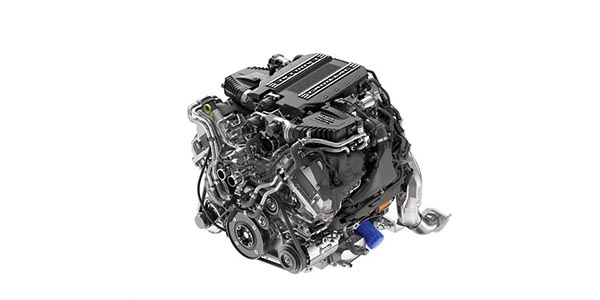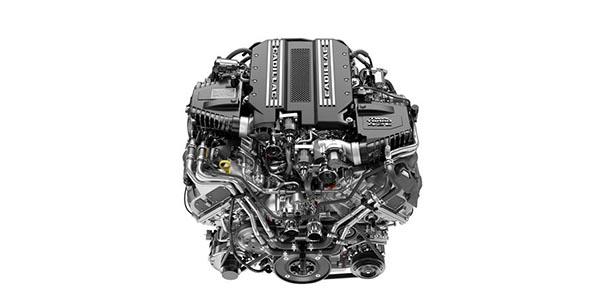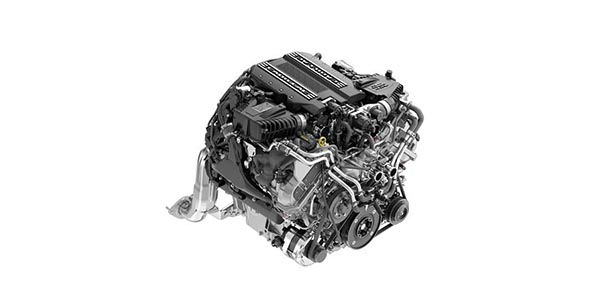Cadillac begins a new chapter in its high-performance legacy with the introduction of the brand’s first-ever twin-turbo V8 engine. It is the centerpiece of the new CT6 V-Sport, a sports sedan infused with DNA of Cadillac’s motorsports program.
Developed as a small-displacement V8 in the classic vein and offering exceptional power density of 131 hp per liter, this new Cadillac-exclusive 4.2L Twin Turbo V8 — GM estimated at 550 horsepower and 627 ft.-lbs. of torque — elevates the CT6’s performance to a new plateau. An optional 500-horsepower version will also be available.

The new Cadillac Twin Turbo V8 is a clean-sheet design that also introduces unique design elements developed to balance performance and efficiency with compact, mass-efficient packaging.
At the center of the 4.2L Twin Turbo V8 is a “hot V” configuration that transposes the conventional layout of the cylinder heads’ intake and exhaust systems to mount the turbochargers at the top of the engine — in the valley between the heads — to virtually eliminate turbo lag and reduce the engine’s overall packaging size.
In a conventional turbocharged engine, the cylinder heads receive the pressurized air charge through ports at the top of the engine and the exhaust exits through ports on the lower outside of the heads into manifolds connected to the turbochargers.
With Cadillac’s innovative hot V design, the intake-charged air enters through the lower outside of the heads and exits through the top inside — where the turbochargers are integrated with the exhaust manifolds — for quick spool-up that translates into more immediate power delivery. The design also allows closer mounting of the catalytic converters, for efficient packaging.
Each engine will be hand-built at the Performance Build Center in Bowling Green, KY.
SMALL DISPLACEMENT, LARGE EFFECT
The new Cadillac Twin Turbo V8’s foundation is an all-new, durable and lightweight aluminum cylinder block that houses an equally robust, lightweight rotating assembly composed of a forged steel crankshaft, forged steel connecting rods and high-strength aluminum pistons.
The crankshaft’s 3.55 inch stroke complements the cylinder bores’ 3.39 inch diameter to give the engine its 4.2L 255 cubic-inch displacement.

Its comparatively small bore dimension enables the reduction in the size and weight of the pistons, optimizing the engine’s geometry to match the fast-rev capability permitted by the engine’s low-inertia, twin-scroll turbochargers. The result is exceptional responsiveness and immediacy of power across the rpm band.
The turbochargers produce up to 20 pounds of boost and are matched with electronic wastegate control for more precise boost management and more responsive torque production. In fact, 90 percent of the engine’s peak torque is available at only 2,000 rpm, and it is carried through 5,200 rpm for a confident, virtually bottomless power reserve.
TWIN-SCROLL TURBOCHARGERS
The turbos’ twin-scroll design broadens their performance capability, offering quicker response and greater efficiency. Rather than a single spiral chamber (scroll) feeding exhaust gas from the exhaust manifold to drive the turbine on each turbocharger, the twin-scroll design has a divided housing with two exhaust gas inlets and two nozzles to drive the turbine. Generally, one of the nozzles contributes to quicker response and boost production, while the other contributes to overall peak performance.
Each of the engine’s integrated exhaust manifolds/turbocharger housings splits the exhaust channels from the cylinder head so the exhaust flows through separate scrolls based on the engine’s exhaust pulses. When matched with precise valve timing, that separation leverages exhaust-scavenging techniques to optimize gas flow, improves turbine efficiency and reduces turbo lag.
The electronically controlled wastegates — one per turbocharger — are used for more precise management of the engine’s boost pressure and subsequent torque response for smoother, more consistent performance. They are independently controlled on each cylinder bank to balance the turbo compressors’ output, for greater boost pressure response.
WATER-TO-AIR CHARGE COOLING AND DUAL THROTTLE BODIES
An efficient water-to-air charge-cooling system contributes to the engine’s performance, enhancing the turbochargers’ effectiveness. Similar in concept to an engine’s radiator, the system’s intercoolers cool the boosted air charge before it enters the cylinders. Cooler air is denser, which means there is more oxygen in a given volume, resulting in optimal combustion and more power.
The system features a pair of heat exchangers located above the valley-mounted exhaust manifold/turbocharger housings. The turbos pump pressurized air directly through the heat exchangers and into the cylinder heads. The heat exchangers are cooled by their own coolant circuit.

The intercoolers lower the air charge temperature by more than 130 degrees F, packing the combustion chambers with cooler, denser air. Also, the system achieves more than 80 percent cooling efficiency with only about 1 psi flow restriction at peak power, which contributes to fast torque production.
Before entering the combustion chambers, the cooled air charge flows through a pair of throttle bodies, one for each engine bank. Each electronically controlled throttle body has a 59mm diameter opening.
NEW 10-SPEED TRANSMISSION
The new Cadillac Twin Turbo V8 is matched with a 10-speed automatic transmission. Its wide, 7.39 overall gear ratio spread enhances off-the-line performance and contributes to reduced engine speed on the highway, which enhances refinement and efficiency. Smaller steps between the gears also help the engine maintain the optimal speed for maximum power at almost all vehicle speeds.
ADDITIONAL TECHNOLOGIES
Direct fuel injection is used to optimize efficiency and performance. With direct injection, a higher compression ratio — 9.8:1 — is possible because of a cooling effect as the injected fuel vaporizes in the combustion chamber, reducing the charge temperature to lessen the likelihood of spark knock. A pair of engine-mounted, camshaft-driven high-pressure fuel pumps supplies fuel to the specialized injectors at 5,075 psi, with each pump supplying fuel to one bank of the engine.
Active Fuel Management (AFM), also known as cylinder deactivation, imperceptibly shuts down half of the engine’s cylinders in certain light-load driving conditions to enhance fuel economy. Unique deactivating rocker arms are used for each of the four valves of the cylinder being deactivated.
Dual overhead camshafts and a virtually silent chain-driven valvetrain contribute to the smoothness and the high output of the Cadillac Twin Turbo V8, while dual independent continuously variable valve timing helps deliver optimal performance and efficiency. The dual independent system, which allows the intake and exhaust valves to be phased at different rates, promotes linear delivery of torque with near-peak levels over a broad rpm range, and high specific output (horsepower per liter of displacement) without sacrificing overall engine response or drivability.
Oil jets located in the block are employed for performance and temperature control. Four jet assemblies in the engine drench the underside of the pistons and the surrounding cylinder walls with an extra layer of cooling, friction-reducing oil. The jets reduce piston temperature, allowing the engine to produce more power without reducing long-term durability.
Variable-pressure oiling system. A variable-displacement vane oil pump enhances efficiency by optimizing oil pressure as a function of engine speed. With it, the oil supply is matched to the engine load rather than the linear operation of a conventional, fixed-flow oil pump. The engine uses 10 quarts of General Motors’ dexos2 0W40 motor oil.
Stop/start technology shuts down the engine when the vehicle stops momentarily, such as at stoplights. The engine automatically restarts when the driver takes their foot off the brake. An auxiliary battery powers electric accessories such as the climate system, power windows and radio during engine restarts.
